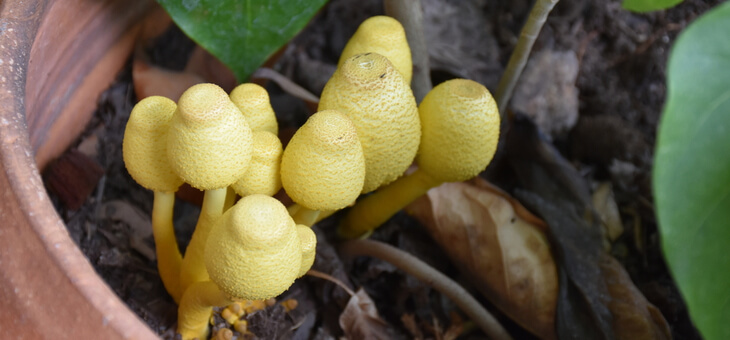If you’ve been in a region affected by the massive amounts of rainfall lately, you may have noticed some odd things going on inside your house. From mould starting to creep along your ‘good’ leather bag that you keep stored away to the laundry never quite drying on the rack. One thing I’ve unfortunately noticed is mushrooms popping up in my houseplants.
Fungi can grow in some extreme environments, at the bottom of deep seas, in deserts, in outer space, the grout in your shower and even inside unstable nuclear reactors. They are incredibly interesting organisms, but I don’t want them in my house unless they’re in the fridge waiting to be stirred into a mushroom risotto.
Read: How to connect with nature indoors
How do they get into houseplants?
Potting mix can be contaminated before you buy or source it, just one mushroom spore can grow rapidly in the right conditions. But mushroom spores can land in your pot plants at any time. A spore can attach to your clothes, and you can bring it into your home. If the plant is near a window, a spore can even be blown in by the wind.
What mushrooms are they?
Mushrooms are actually the fruit of a fungus. One of the most common mushrooms found growing in houseplants is the Leucocoprinus birnbaumii, formerly named Lepiota lutea. They are small and often found in varying shades of yellow. These are so frequently seen in pots in greenhouses and homes that the common names are plantpot dapperling and flowerpot parasol.
The cap of these mushrooms is oval shaped at first and will become more bell-shaped when mature. If you look closely, you will see that the cap has interesting patterns of bumps and lines. This mushroom will only get a few inches tall.
But it’s important to remember that there are more than 10,000 known types of mushrooms. So, it may well be a different, more toxic, type of mushroom in your houseplant.
Most frequently, mushrooms will appear in houseplants in the summer when conditions are right for them. Unlike lawn mushrooms (which prefer cool, moist conditions), mushrooms in houseplants prefer that air be warm, moist and humid.
If you’re anywhere near New South Wales at the moment, this will probably sound very familiar to you.
Read: How to grow mushrooms and help save the earth
Are they bad for the plants?
Flowerpot parasols are not parasitic mushrooms. In fact, they are what is called a saprotrophic mushroom, which just means that they feed on dead organic matter.
They will feed on the dead roots, insects and decaying potting material and then release material back into the soil in a way that the plant can use as food. So, they can be beneficial but it certainly isn’t necessary to leave them in the plant.
To remove or not to remove
Eliminating mushrooms in houseplants can be difficult once they’re established.
Once the soil becomes infected, it is very difficult to remove the spores and fungus that causes the mushrooms, but there are a few things you can try.
Remove the caps as soon as possible.
By removing the fruit, you are removing the source of the spores that will allow more mushrooms to grow. This will also help keep mushrooms out of your other houseplants.
Scrape the top four or five centimetres of soil off.
Removing the top layer of soil and replacing it may help, but if you don’t completely remove the fungus the mushrooms will return.
Read: How houseplants can make you feel like you’re on holiday
Change the soil.
Repotting the plant with new soil may possibly help with getting rid of mushrooms. But it’s not healthy to remove all of the soil from a plant’s roots (through washing or rinsing) and the fungus may still be present and regrow from the soil left on the roots of the houseplant.
Drench the soil with fungicide.
You may need to try this treatment several times before the fungus is killed completely.
Change the conditions.
If the air is less humid, the soil less moist or the temperature less warm, this will reduce the number of mushrooms that appear. Unfortunately, the conditions that are ideal for mushrooms are also ideal for most houseplants, so by changing the conditions you may harm the houseplant itself.
Most of the time people have houseplants because they want to bring a little bit of the outdoors into their home. But mushrooms may be a step too far.
If you enjoy our content, don’t keep it to yourself. Share our free eNews with your friends and encourage them to sign up.

